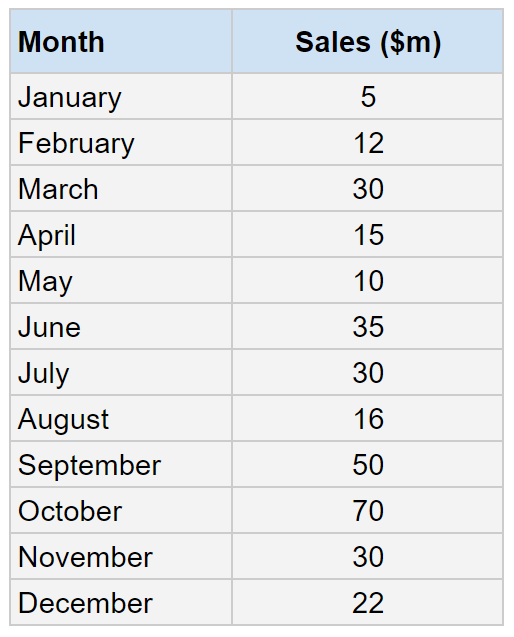BMT Simple linear regression (HL)
Is somebody getting fired?
The CEO of X-peng (a Chinese EV car company) has asked for reliable data on car sales staff at the firm from one of their smaller, regional offices!
The CEO is pretty unhappy with sales performance and wanted to see if there is a link between experience (years) and volume of sales made.
To shed some light on this issue, the CEO decided to have the data analysed!


QUESTIONS: IS SOMEBODY GETTING FIRED?
- Using the data above, use a scatter diagram to plot the data to show sales per month against years at Xpeng [4]
- Draw an appropriate line of best fit on the scatter diagram you constructed [1]
- Identify two outlying data points (members of the sales team) from the scatter diagram [2]
- Using your response from question 3, suggest what they mean in terms of these two members of staff [4]
- Interpret (using the scatter diagram) whether or not the number of years and sales are correlated strongly, weakly or not at all [2]
- Determine which member of staff is in most need of training in order to improve their monthly sales [1]
- Suggest whether or not there is an argument to introduce performance related pay (which is something that both Kate and James would like to see introduced) [4]
Sales of Edrive cars
The Chinese EV market is booming, with loads of new car makers coming to the market. Here we focus on ‘Edrive’.
The manager wants to forecast sales into the future to help create a budget.
Since beginning trading, Edrive has seen some big changes in sales.
The sales data for Edrive can be seen on the right!

QUESTIONS: WHAT HAPPENS NEXT FOR EDRIVE?
- Plot a scatter diagram of the sales for Edrive (sales on the Y axis and months on the x axis) [4]
- Comment on your findings from your scatter diagram [2]
- Draw an appropriate line of best fit for Edrive [1]
- Using the technique of extrapolation, forecast the likely sales for the following January and February [2]
Unit BMT Simple linear regression overview
Linear regression models are statistical methods employed to identify the apparent relationship between two variables, such as marketing expenditure and sales revenue, or the seasonal effects on the demand for specific goods and services.
These techniques are:
Scatter diagrams
The ability to ascertain correlation enhances business decision-making and strategic planning!
SUGGESTED ANSWERS TO...
1 Using the data above, use a scatter diagram to plot the data to show sales per month against years at Xpeng [4]

2 Draw an appropriate line of best fit [1]

3 Identify the two outlying data points (members of the sales team) from the scatter diagram [2]
Kate and James seem to be the two outlying members of staff who are performing ahead of the other members of the sales team.
4 Using your response from question 3, suggest what they mean in terms of these two members of staff [4]
Kate:
James:
5 Interpret (using the scatter diagram) whether or not the number of years and sales are correlated strongly, weakly or not at all [2]
Correlation suggests that the two variables are related (years of work and number of sales) in this case! The scatter diagram does show correlation, which is to be expected. Whist there are outliers, there is a reasonably strong correlation between the two variables.
6 Determine which member of staff is in most need of training in order to improve their monthly sales [1]
The scatter diagram is not that useful when it comes to identifying the under-performer!
One way to examine the data would be to quantity how many sales on average does one years experience lead to.
For example, for Kate (the star performer) 17 sales per month / 2 years experience gives an average of 8.5 cars sold per year of experience!
However, at the other end of the spectrum is Sally with 22 sales per month / 13 years which gives the lowest number pf 1.6 cars sold per month for each year of experience
7 Suggest whether or not there is an argument to introduce performance related pay (which is something that both Kate and James would like to see introduced) [2]
There is a general trend of more experience equates to more cars sold. However, the manager may wish to invest in more training for the following reasons:
1.) Kate has shown that inexperienced staff can sell high volumes!
2.) The reverse is true!
3.) The manager may wish to cement this trend by incentivizing through increased pay.
4.) There are many arguments to support the introduction with PRP, certainly for Kate and James who desire more money for their extraordinary sales success.



How does forecasting work in the real world?
In the IB Business Management curriculum, the Business Management Toolkit (BMT) Unit 6 emphasizes the critical role of forecasting within the Business Management Toolkit (BMT). Forecasting equips students with the analytical tools necessary to predict future sales trends, enabling companies to make informed decisions and maintain a competitive edge. Simple linear regression is just one part of forecasting. Also, this technique and tool from the BMT can be used in the Internal Assessment for IB Business Management. Indeed, it’s a great one as it shows that you can use data without using up lots of your allotted word count that can happens with more qualitative tools (like SWOT or STEEPLE)!
Forecasting (simple linear regression) involves analyzing historical data and market indicators to anticipate future demand. This proactive approach allows businesses to optimize inventory levels, allocate resources efficiently, and tailor marketing strategies to meet anticipated consumer needs. Incorporating forecasting into business practices not only enhances operational efficiency but also mitigates risks associated with market volatility. It also helps identify the need for finance or source of finance or cash!
Several industries have successfully implemented forecasting
Fashion Industry: The rapid change of fashion trends necessitates precise demand forecasting. Companies like those utilizing AI-powered platforms analyze data from social media, e-commerce, and runway shows to forecast consumer preferences.
Retail Sector: Major retailers employ alternative data sources, such as credit card transactions and consumer sentiment surveys, to forecast sales during peak seasons. This strategy enables them to adjust inventory and try not to under or over provide stock, which can be wasteful or damaging to reputation!
Integrating forecasting into business strategies, as highlighted in Unit 6 of the IB Business Management course, empowers you to apply theoretical knowledge to real-world scenarios. By mastering this tool from the Business Management Toolkit (BMT), you can score well on the exam and perform well on the Internal Assessment (IA) for the IB BM course!


